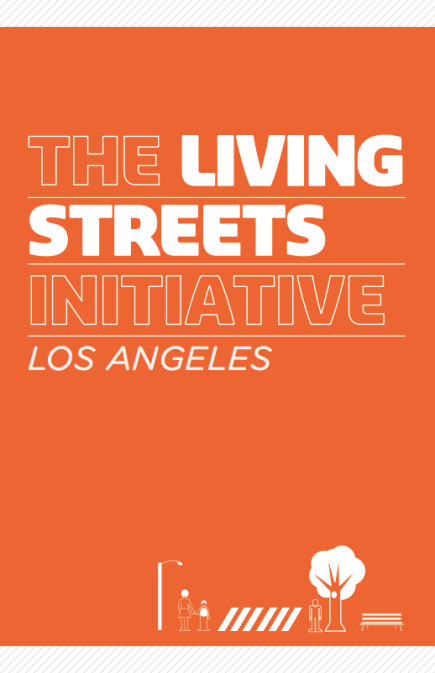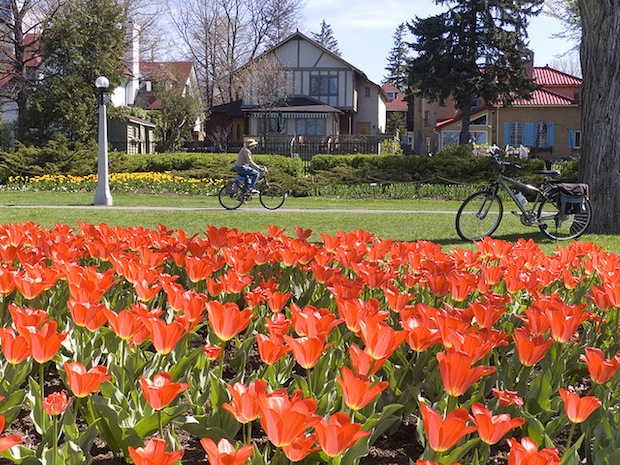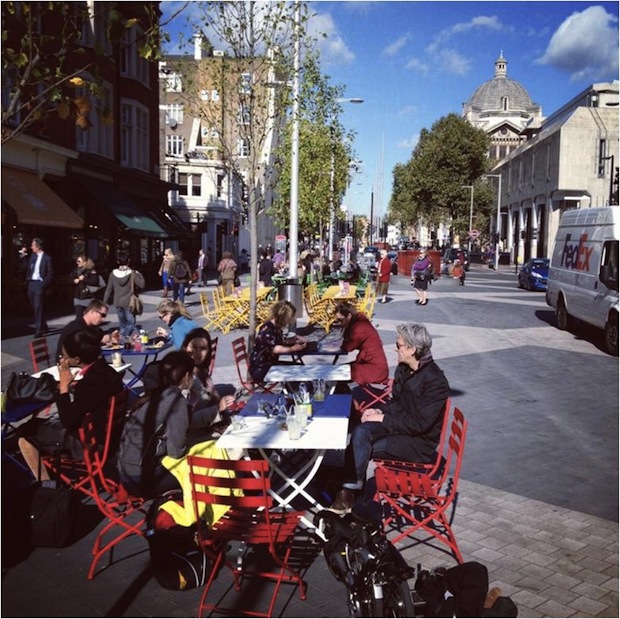How-to-Guidebooks for Community-Driven Street Improvements
By Larry Kaplan
A steady, dramatic shift is happening in the way Americans think about urban life, moving toward streets that are centered around people. In Southern California, we’d expect to see this in communities known for their cutting edge approach to urban design, like Santa Monica and West Hollywood.
But on the East Side? Yes, there too. We’re talking about two projects by the Green LA Coalition’s Living Streets Initiative—on York Boulevard in Highland Park and Huntington Drive in El Sereno.
 Green LA’s Ryan Lehman, who chairs the initiative, partnered with Steve Rasmussen Cancian of Shared Spaces Landscape Architecture, to bring together community stakeholders and create a vision for improving the burgeoning stretches of street—and at the same time, realize immediate visible changes. This was the vision of LA Councilmember José Huizar, who represents the area.
Green LA’s Ryan Lehman, who chairs the initiative, partnered with Steve Rasmussen Cancian of Shared Spaces Landscape Architecture, to bring together community stakeholders and create a vision for improving the burgeoning stretches of street—and at the same time, realize immediate visible changes. This was the vision of LA Councilmember José Huizar, who represents the area.
The York Blvd. Action Plan is a guide for realizing the Highland Park community’s vision for an improved York Blvd. In 2011, over 200 local residents, business people and organizational leaders worked together in over 15 workshops to develop a shared vision for improving it.
Not far away, the Huntington Dr. Action Plan realizes the El Sereno community’s vision for improving their own “downtown”- along Huntington from Maycrest Ave. to Collis Ave. Also in 2011, over 150 local residents, business people and organizational leaders worked together in 10 workshops to develop a shared vision for improving this important stretch of street.
So what is an Action Plan? Action Planning focuses on immediate and medium term improvements that can be implemented relatively quickly, inexpensively and incrementally. While traditional master plans develop an ideal vision of a place-and then draw that vision as a guide to future projects that may never happen, action planners ask, “If we have X dollars to spend this year, which improvements should we make? And then, once those are done, what comes next?”
Once the community answers these questions, action planners actually implement the neighborhoods’ top choices, primarily low-cost improvements that can be designed and built relatively quickly, using these immediate projects to build momentum. Then the planners create a guide with step-by-step work plans and tools, so that community members can implement the balance of their priorities as resources become available. Between the two plans, the Living Streets team distilled the many ideas brainstormed and discussed by community members into do-able actions that will incrementally improve two key area streets.
“Streets are not there only to balance the needs of walkers, bicyclists, transit riders and drivers. Environmental restoration, economic equity and community engagement are essential to revitalizing neglected neighborhoods, so transforming streets in the City’s urban core into vibrant, inviting and green community spaces is a great way to show that this approach works,” says Ryan.
The York Blvd. Vision Project exemplified this Action Planning process. “When I saw the meeting announcements, I had just opened my business,” says Cathi Milligan, who owns the Glass Studio, an art gallery on York, “I wanted to be a part of the process, which was amazing—it was a successful way of getting community feedback. It allowed the community to be educated about the options and make intelligent decisions, and people were excited.”
Through this planning process, the community created a truly shared vision, and developed a strategic list of cost effective, incremental improvements that together would realize their vision.
Now, three immediate projects are already being realized by the York Blvd. community:
-Creating a Street Porch on York between Avenues 50 and 51.
-Creating a park on the southwest corner of York and Ave. 50
-Installing a demonstration phase of pedestrian street lights with an historic character.
The York Porch will be built in the fall of 2012 as one of four Council District 14 demonstration projects that will set the standards for street porches—and all types of parklets and mini-plazas—across Los Angeles. The community’s vote to prioritize applying for funding to create a park resulted in a $2.85 million state grant to purchase the lot on the southwest corner of York Blvd. and Ave. 50 and develop it as a hybrid neighborhood park and Main St. Plaza that weaves together the boulevard and the surrounding residential neighborhoods.
“Through this step-by-step, improvement-by-improvement, process, the people of Highland Park are already realizing their vision of an improved York Blvd.,” says Councilmember Huizar, whose staff was instrumental in the process.
The Huntington Dr. Action Plan, also in the Councilmember’s district, was developed through the same community engagement and design process. Community members sought to create a town square atmosphere where people are encouraged to stop, shop and relax; to green, brighten and lighten-up El Sereno’s “downtown;” and to accentuate the creative, local, and historic character of the community.
After creating a list of improvement components, community participants voted to prioritize two of them for immediate implementation:
-A Street Plaza in the center of downtown in front of Food for Less.
-A sidewalk plaza at the northern gateway to El Sereno at Maycrest Ave.
The El Sereno St. Plaza was created by the community in multiple workshops, in which they sought to combine the neighborhood’s cultural and natural history to create an “only in El Sereno” space. The Street Plaza will be built in the fall of 2012 as one of four 14th District demonstration projects that will set the standards for street plazas across Los Angeles. And while the community’s first focus was a gathering place at the center of downtown, participants were equally clear that it was important to mark and improve El Sereno’s gateways, beginning with the commercial corner at the northern end of downtown at Maycrest Ave.
A version of this article was sent to the Green LA Coalition’s e-newsletter list.
Read the plans on Issuu below or download them here.












